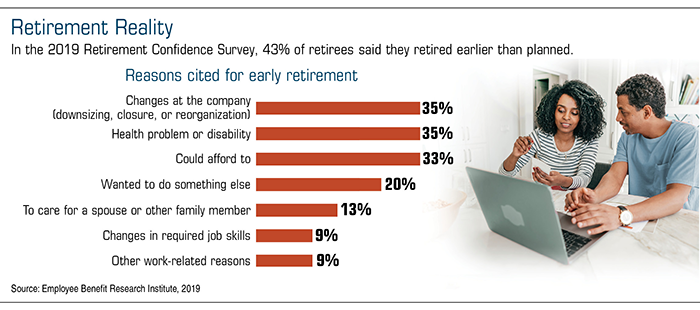Early Retirement and Your Tax-Deferred Savings: When Can You Take Penalty-Free Withdrawals?
Saying goodbye to the working world might be a dream come true, particularly for hardcore savers inspired by the high-profile movement dubbed FIRE (Financial Independence Retire Early). Unfortunately, many others are forced to leave the workforce abruptly or must tap into retirement savings for other pressing needs.
When it comes to the money in tax-deferred retirement plans, it doesn’t matter whether you are a proponent of FIRE or are unexpectedly fired. Withdrawals taken prior to age 59½ are normally subject to a 10% federal tax penalty — unless an exception applies — on top of ordinary income taxes.

There is usually no way to avoid the income tax, but there are situations in which you can take penalty-free distributions from tax-deferred retirement accounts before reaching age 59½. The rules for the following penalty exceptions differ depending on whether the money is withdrawn from a traditional IRA or an employer-sponsored plan such as a 401(k) or 403(b).
For Your Health’s Sake
Account holders who become permanently disabled (unable to engage in any substantial gainful activity) are not subject to the early-withdrawal penalty. The 10% penalty is also waived when early distributions are used to pay unreimbursed medical expenses (for you, your spouse, or your dependents) that exceed 7.5% of modified adjusted gross income (in 2019 and 2020). These two exceptions apply to employer plans and IRAs.
IRA withdrawals used to pay health insurance premiums may also be exempt from the penalty, but only if the account owner receives unemployment benefits for 12 consecutive weeks. This exception does not apply to employer plans, which might be an important distinction if you lose a job and no longer have access to employer-provided health benefits.
For coronavirus-related retirement plan distributions up to $100,000 in 2020, the 10% early-distribution penalty has been waived by the Coronavirus Aid, Relief, and Economic Security (CARES) Act.
To Help Fund Milestones
IRA distributions can be used for a first-time home purchase ($10,000 lifetime maximum) — or even to help a qualifying spouse, child, grandchild, or parent purchase a first home — without incurring the penalty. The tax code defines a first-time homebuyer as someone who has not owned a principal residence during the previous two years.
IRA funds withdrawn to pay qualified higher-education expenses — for IRA owners and their spouses, children, and grandchildren — are also penalty-free. Keep in mind that neither of these exceptions is available for employer plan distributions.
Because You Can (or Need the Money)
Workers who separate from their employers during or after the calendar year in which they reach age 55 can withdraw funds from an employer-sponsored retirement plan without a tax penalty (age 50 for qualified public safety employees). This rule does not apply to IRAs, so if an employer plan distribution is rolled into an IRA, you would have to wait until age 59½ to access those funds without triggering the 10% penalty.
There is only one way that you can take penalty-free distributions at any age and for any purpose. Under IRS Section 72(t), employer plan participants (if separated from service) and IRA owners can set up a series of substantially equal periodic payments (SEPPs) that are based on life expectancy. One caveat is that 72(t) payments must continue for at least five years or until age 59½, whichever occurs later, even if you no longer need the income. Modifying the agreed-upon payment schedule in any way could result in a 10% penalty (plus interest) on all early distributions.
Taking early distributions means you lose the opportunity for some of your retirement contributions and earnings to continue compounding tax deferred. This is one of many reasons it could be a bad idea to take money from your retirement accounts before age 59½. But if you must, or if you are confident that your current savings will last throughout a long retirement, it’s a good idea to have a well-designed distribution strategy in place.
This information is not intended as tax, legal, investment, or retirement advice or recommendations, and it may not be relied on for the purpose of avoiding any federal tax penalties. You are encouraged to seek advice from an independent tax or legal professional. The content is derived from sources believed to be accurate. Neither the information presented nor any opinion expressed constitutes a solicitation for the purchase or sale of any security. This material was written and prepared by Broadridge Advisor Solutions. © 2020 Broadridge Investor Communication Solutions, Inc.
Ready to Take The Next Step?
For more information about any of our products and services, schedule a meeting today.

